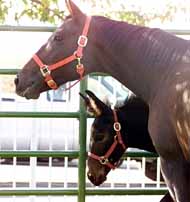Cloned mules are three-of-a-kind
Under natural circumstances, mules can’t reproduce, they are sterile animals.
But after the successful partnership between Utah State University and the University of Idaho, there are three mules that are genetically identical – three clones.
One of the mules, Utah Pioneer, was on display Saturday at the Ag Products Barbecue at the Maughan Track Stadium. Utah Pioneer’s surrogate mother Idaho Rose was on display as well.
Since May 4, the three mules have been the only members of the equine species ever cloned, said USU professor of animal science Kenneth White, a member of the cloning research team.
The team, which included Idaho professor of animal and veterinary science Gordon Woods and professor Dirk Vanderwall, produced the three clones from a total of 113 cloned embryos, White said.
Utah Pioneer, Idaho Gem and the other yet to be named animal, were born healthy and normal, something that some of those who come to observe the mule have been unable to understand, said Jessica Williams, a doctorate student who worked under Vanderwall.
“People say ‘well, that’s just a mule,’ and we say ‘yeah, that’s what we were hoping for,'” Williams said. “I think they expect an extra ear or something.”
Williams said the goal is for the mules to be normal, healthy and happy.
“If he was in a pasture somewhere you’d never tell the difference from him or another mule,” she said.
The healthy births of the mules started in the laboratories where they were actually cloned White said. While cloning is a complicated process, the process itself takes place in about a six-hour period.
“The cloning process itself, it’s only minutes, a half an hour maybe,” White said.
The process requires recovering an unfertilized egg from a horse and extracting the genetic material from that egg with microsurgery tools, he said.
The scientists then take a cell from a sample of skin and put that next to the egg with the genetic material in it. The membranes from the materials are then caused to fuse by introducing the nucleus from the skin cell into the egg. The egg is then transferred into a mare, and if successful, the mare becomes pregnant.
In the case of Utah Pioneer, the surrogate mother carried the mule for 346 days before its birth.
White said there were a lot of obstacles in the cloning process, as mules are a far different species to clone in comparison with sheep and cattle. The experience of successfully cloning mules will benefit future cloning research.
The cloning of a sterile animal will also be very beneficial to the agricultural community, White said.
“It’s very common of us for production purposes to sterilize an animal, either cattle or horses, just because it makes it much simpler to manager the animal,” he said. “The unfortunate thing is sometimes those decisions are made before you know the full potential of the animal.”
White used the racing horse Funny Cide as an example of a sterilized horse that almost won the Triple Crown last summer, horse racing’s top honor.
Aside from providing advancements in the cloning field, the project, named Project Idaho, presented an opportunity for students from the two schools to get hands-on agriculture science experience.
Ki Aston, a USU graduate student, helped out through the cloning process.
“For the last two years we went up [to Moscow, Idaho] a week at a time and I was involved in setting up for the cloning process,” Aston said. “It was a lot of fun, it’s a change from the work that we do down here.”
Aston said perseverance is one thing he learned from the project that will help him in his future career.
“It took several years to even start to see some glimmers of hope, and then a couple of years after, things started to look like they were working to actually have a finished project,” he said. “In research, a lot of times successes are few and far between.”
A major contribution in the cloning project came from Post Falls, Idaho businessman and mule racing enthusiast Don Jacklin who contributed $400,000 to the project, Williams said.
The three cloned mules were cloned from a full brother to Jacklin’s champion racing mule Taz, Williams said.
Williams said it would not be possible to breed a super-mule for racing purposes through cloning, as you are making identical copies when you clone, not breeding up.
It could be expected for the cloning team to receive some negative feedback as cloning has been a controversial issue over the past years, but White said the feedback has been overwhelmingly positive.
“There’s some crackpots that it really doesn’t make any difference what we’re doing, whether we’re cloning or artificially inseminating animals or whatever, they’re not going to be happy with it,” he said.
After the mules finished their appearance at the barbecue, they were scheduled to return home to Idaho. White said the project has been exciting and successful.
“Three really healthy normal born babies,” he said. “It’s pretty exciting.”
-str@cc.usu.edu

Utah Pioneer the second in a trio of cloned mules, stands behind his surrogate mother, Idaho Rose. The mules were on display Saturday during the Ag Products Barbecue at Maughan Track Stadium. (Photo by Scott Davis)

